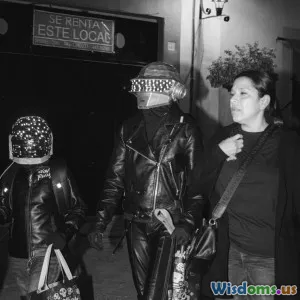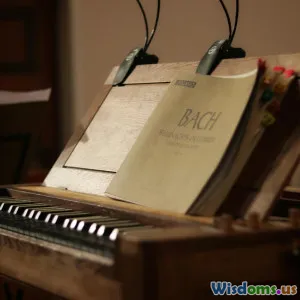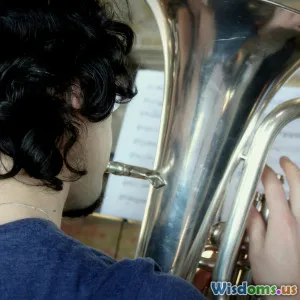
What Drives Jon Batiste to Blend Genres So Boldly
10 min read Explore the innovative fusion of genres by Jon Batiste and uncover the inspirations behind his bold musical blend. (0 Reviews)
What Drives Jon Batiste to Blend Genres So Boldly
Jon Batiste is more than a musician; he is a musical storyteller who dissolves boundaries between genres, crafting a signature sound that is as innovative as it is soulful. His blend of jazz, R&B, pop, classical, and traditional New Orleans styles has captivated audiences worldwide, redefining contemporary music. But what fuels Jon Batiste’s fearless fusion of these wide-ranging genres? This article ventures beyond the spotlight to uncover the driving forces behind his bold musical explorations.
The Roots: A Heritage Steeped in Musical Diversity
To understand Batiste's genre blending, one must first look at his upbringing. Born and raised in Kenner, Louisiana, a suburb of New Orleans, Jon Batiste grew up immersed in a rich cultural and musical melting pot. New Orleans, famed for jazz and its vibrant musical traditions, offered Batiste the perfect incubator for stylistic cross-pollination.
His earliest influences stem from a family tradition of musical excellence. Coming from a lineage of musicians, Batiste’s grandfather and father instilled in him the sacred rhythm of jazz and the call-and-response patterns fundamental to soul music and gospel. These family musical sessions exposed him early to diversity within music — combining elements of blues, jazz, and R&B, laying a foundation that encouraged blending rather than separation.
According to Batiste, in interviews, New Orleans’ musical heritage inherently embraces hybridity. As he once said, "In New Orleans, we don’t think about genre first; we think about the music’s feeling and story, and that naturally leads you to mix styles.” This perspective frames the way he approaches his music — as a living, breathing art form that draws from many wells.
Intellectual Curiosity and Formal Training
Batiste’s formal musical education at the Juilliard School expanded his palette further. Here he delved deeply into classical music’s structural complexities, jazz theory, and improvisational expertise. This rigorous training equipped him with technical mastery across genres but also nurtured an intellectual curiosity about how different musical traditions intersect.
At Juilliard, collaborations with a diverse cohort of artists opened additional avenues, exposing him to hip hop beats, electronic music production, and global sounds. This eclectic interaction encouraged him to view genre limitations as malleable constructs rather than fixed categories.
This educational background helps Batiste to deconstruct traditional genre rules and reassemble them into innovative compositions — creating music that is at once deeply rooted and daringly futuristic. As he explained in a 2021 NPR interview, "Mastering the fundamentals lets me play freely, to take what I need from any musical tradition and translate it into something fresh and authentic."
Social Consciousness and Music as a Unifying Force
Beyond his heritage and training, another compelling driver behind Batiste’s genre mashups is his vision of music as a tool for social cohesion. Living in a divided society, Batiste channels his art to dissolve barriers—not just musical ones but cultural and racial ones as well.
His time as the bandleader on "The Late Show with Stephen Colbert" has given him a platform to promote messages of unity and resilience. Batiste often uses moments in music programming to blend genres deliberately, reinforcing multiculturalism and shared humanity.
For example, in performances featuring gospel’s emotional power merged with hip hop’s modern edge, Batiste bridges generational gaps and racial divides. His album "We Are" (2021) celebrates this blend of optimism and struggle, granting listeners a sonic space for collective healing. The album topped the Billboard Jazz Albums Chart and won the Grammy for Album of the Year, signaling both commercial and cultural triumph.
His investments in creating the nonprofit ‘‘Stay Human’’ further demonstrate how his blending of musical traditions also corresponds to blending societal views — advocating empathy, education, and interactive experiences to foster understanding.
Technological Innovation and the Art of Experimentation
It’s not just tradition and social vision driving Batiste; technology and experimentation play key roles. In an era where music production is boundless, Batiste harnesses digital tools to weave genres together seamlessly.
He features instruments like the Fender Rhodes electric piano alongside synthesizers, combines live drumming with programmed hip hop beats, and fuses brass band sounds with synthesized textures. These hybrid sounds demonstrate a deliberate intent to explore new musical frontiers.
For example, his song "Movement" blends gospel-infused vocal harmonies, groove-oriented rhythms, and jazz improvisation over an avant-garde production style. This willingness to experiment stems from his belief, expressed in interviews, that "technology broadens the vocabulary of what music can be — enabling genre boundaries to dissolve naturally.”
Additionally, collaborating with producers versed in various styles allows Batiste to add new dimensions to his sound. Whether working with artists like Mina Agossi on jazz/soul fusions, or integrating hip hop rhythms inspired by contemporary producers, he exemplifies how collaboration fuels bold creativity.
Embracing Storytelling: The Heart Behind the Fusion
Ultimately, Batiste’s bold genre blending serves a purpose beyond aesthetics — it is deeply embedded in storytelling. Each musical thread he weaves tells a part of a larger narrative about culture, identity, and universal connection.
On stage, Batiste doesn't just perform; he creates immersive experiences that convey historical depth and personal significance. For example, his incorporation of traditional New Orleans second-line rhythms is not arbitrary but a nod to cultural resiliency and heritage.
When Batiste combines classical piano motifs with jazz improvisation, he reflects the duality of discipline and freedom found in life. Each genre acts as a language with which to express complex human emotions—hope, struggle, joy, reflection.
In his own words, "I want people to feel seen when they listen—to hear their own stories through mine, regardless of the genre they usually prefer.” This intention makes his boldness not just an artistic statement but a bridge to deeper audience connection.
Conclusion: The Boldness of Authentic Fusion
Jon Batiste’s audacious blending of genres is not a reckless journey into novelty but a rooted, intentional exploration shaped by heritage, education, social consciousness, and technological opportunity. His transformation of music transcends labels, inviting us all to rethink boundaries, embrace shared histories, and innovate while honoring the past.
In a world fractured by division, Batiste’s music stands as a testament to the power of boldness grounded in authenticity—a sonic reminder that genres, like people, gain strength and beauty when they blend.
Takeaway
For musicians and listeners alike, Jon Batiste offers inspiration: that bold creativity arises from honoring your roots, staying curious, embracing collaboration, and seeing music as a dynamic dialogue across time and culture. His work whispers an invitation—break the mold, blend boldly, and make music a universal language.
References:
- NPR Music Interview with Jon Batiste, 2021
- Billboard Jazz Albums Chart, "We Are" (2021)
- Stay Human nonprofit mission statement
- Various live performances and interviews available via Late Show with Stephen Colbert archives
Rate the Post
User Reviews
Other posts in Cultural Studies
Popular Posts
















